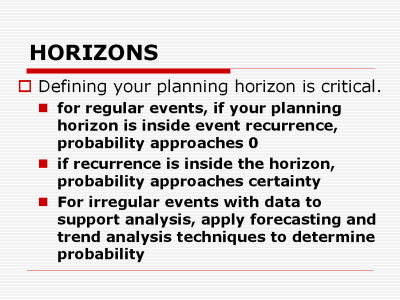 |
Probability is expressed in terms of the
planning or operational time horizon for your organization. Every assessment
of hazards and risks is essentially time based, whether or not we say it is.
The time factor can significantly change your perception of the threat that
a specific type of event can pose. For example, if the local volcano erupts
on an approximate cycle of once every 200 years, based on geologic evidence
of the last 2000 years, its last eruptive cycle finished 10 years ago, and
you are planning for the next 5 years, it is reasonable to lower the
probability of a volcanic event. However, it is not reasonable to rate this
probability as 0.00, as the eruptive cycles of volcanoes are not absolutely
predictable, and your volcano may be the one that proves that. Remember also
that environmental changes will change probabilities, and that in many cases
new understandings of threats or new threats may well emerge during the
period for which you are forecasting risk. In other words, probability is
not fixed – it is dynamic, and must be regularly reconsidered. |
